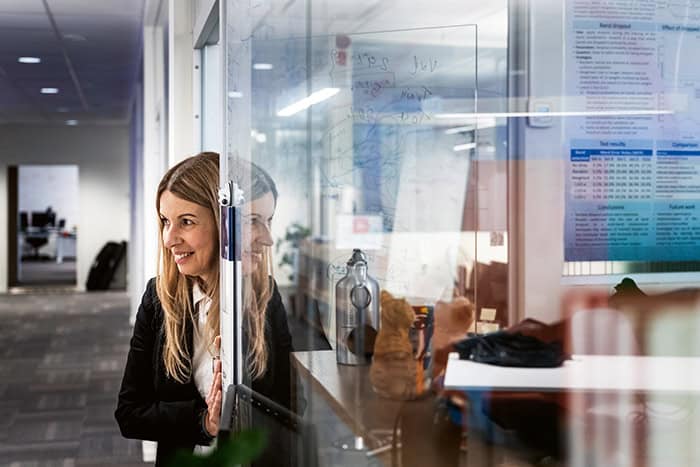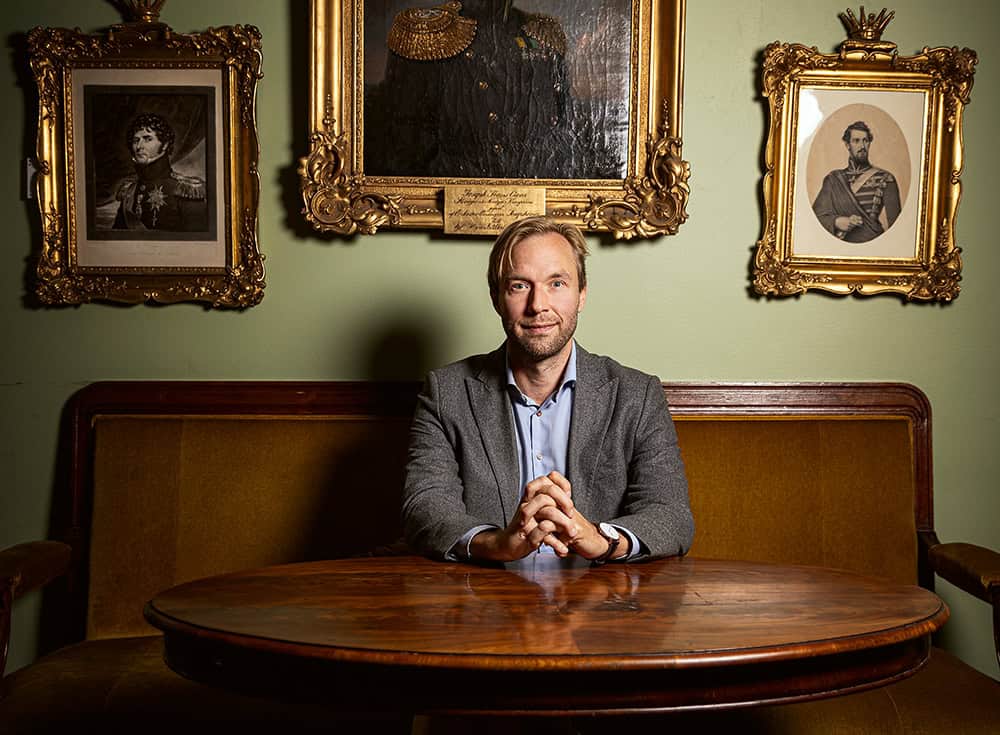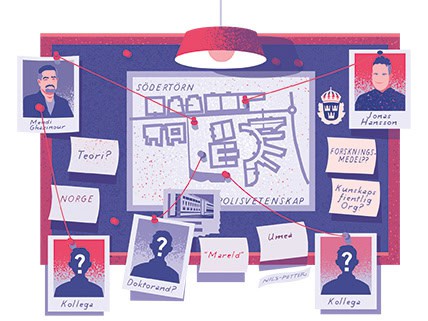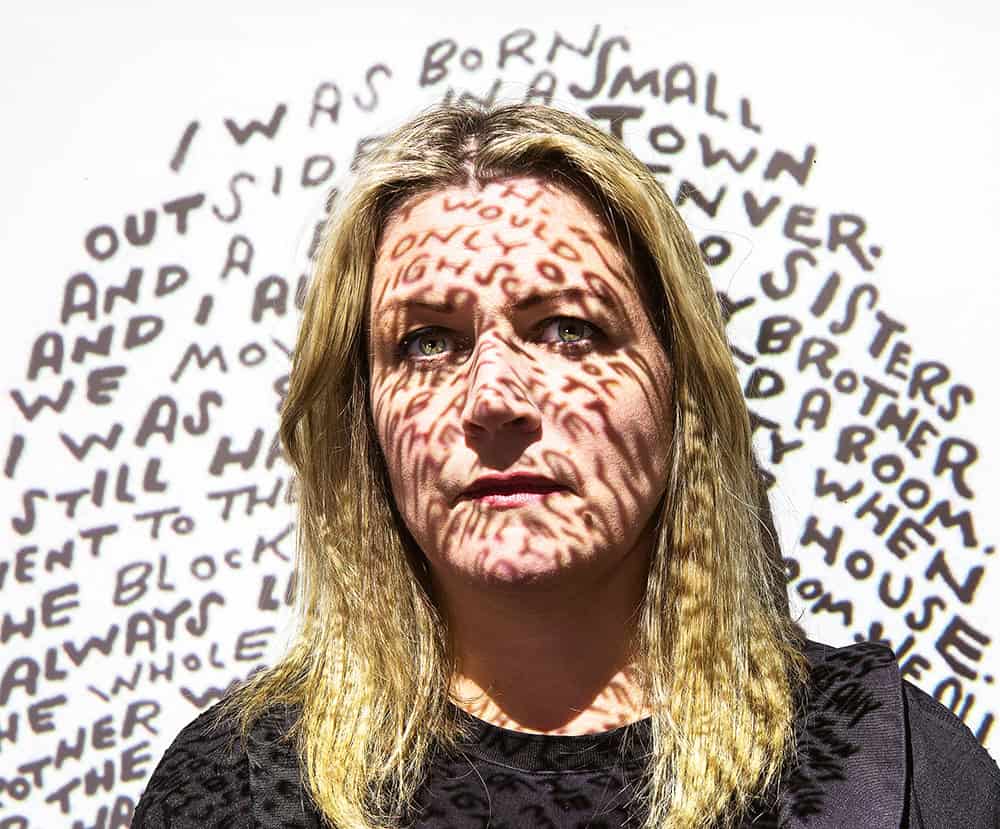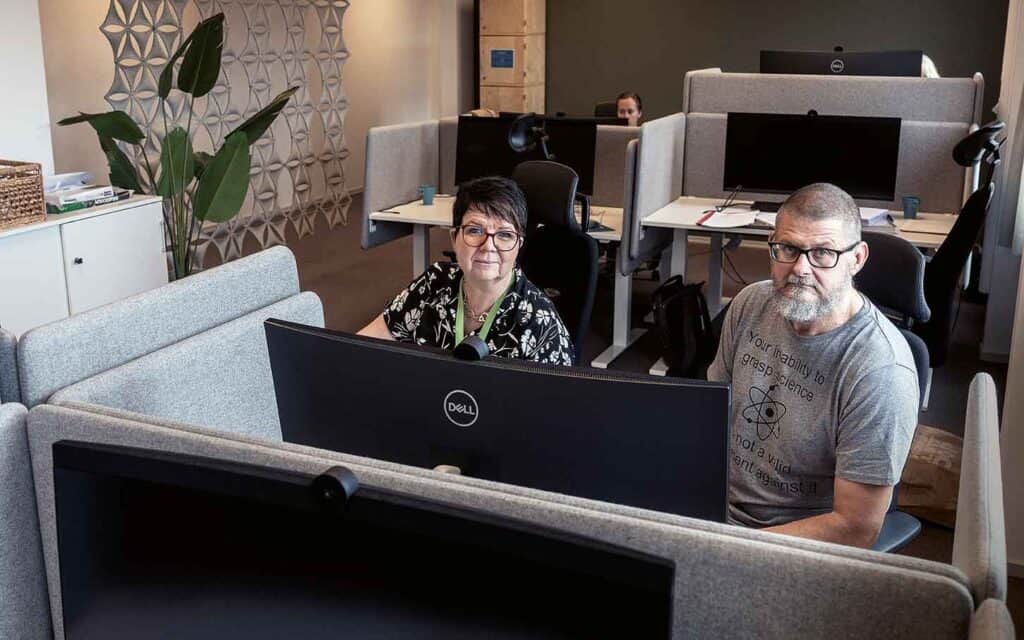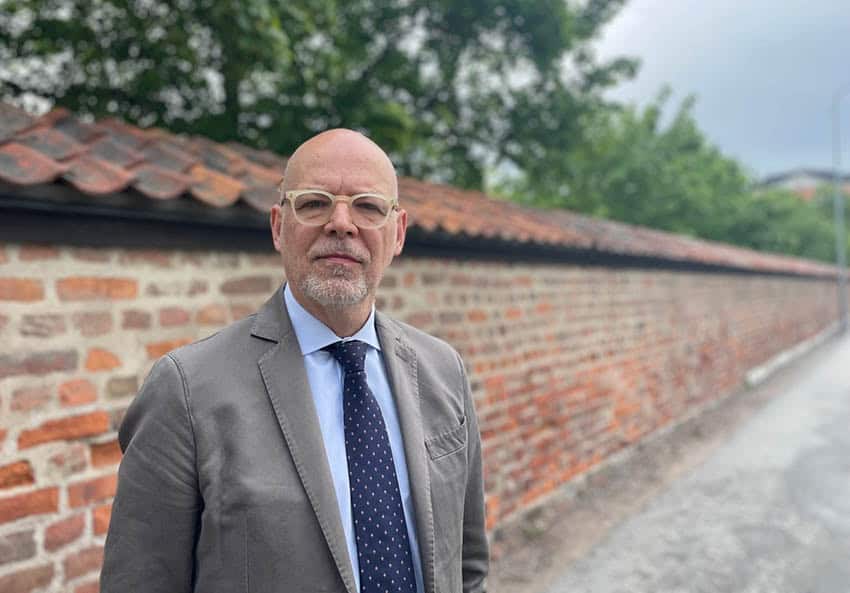In the otherwise unremarkable corridors at Luleå University of Technology, one office environment stands out. It looks modern and lavish. The walls facing the corridor and between the rooms are made of glass. In the entrance, one wall is blue. It is a large illustration of a computer circuit board – a pattern of electronically conductive paths. Where the microchip would normally sit, there is a whiteboard instead.
”AI” is written in the middle. Other concepts radiate from it: machine learning, brain analysis, neuroscience, robotics, sustainable language processing, education.
Among the office rooms there is also one that stands out more than the rest. There are drawings and notes in different colours on the glass walls and the door. There is a picture of a brain with a red ring marking ”inner speech”, where the inner speech function is located. Three graphs, like cone-shaped mountains overlapping each other, have peaks marking the highest level of brain activity after the test subject has seen a certain word.
The scribbles on the glass are part of the thinking process behind an article that Foteini Simistira Liwicki published last year in Nature’s journal Scientific Data. In it, she presented an innovative method for decoding inner speech by measuring electrical activity in the brain.
“We are a long way from translating brain activity into continuous speech,” she says, “but we are training the AI to recognise words that the test subjects are thinking of.”
Simistira Liwicki is one of six female associate professors who have been selected for the university’s merit-based qualification initiative to equalise gender distribution at professor level, where currently 70 per cent are men. As a result, she has been granted 50 per cent research time over two years – an unusually generous gender equality investment.
“It has meant that I have been able to cut back on my administrative work and instead focus more on my research, making grant applications and developing new courses,” she says. “Previously, I led the programme for applied AI, and that took up a lot of my time.”
From 2001 to 2023, the proportion of women among professors in Sweden increased from 14 to 32 per cent. The rate of increase in the proportion of newly recruited female professors, on the other hand, has slowed down, but it is too early to determine whether this is a break in the trend, according to the Swedish Higher Education Authority, UKÄ.
Luleå University of Technology, together with Dalarna University and Konstfack, the University of Arts, Crafts and Design, were the only universities that reached their recruitment targets for professors in 2021–2023. The government set the targets based on a calculation of the gender distribution in the recruitment base. Luleå University of Technology recruited 40 per cent female professors, five percentage points more than the target set for the period.
Swedish higher education institutions’ achievement of targets has deteriorated significantly since the targets were first introduced in 1997. UKÄ is now proposing a number of changes so that the recruitment base better reflects reality.
The time between a doctorate qualification and employment as a professor is increasing, and it is now on average just under 20 years. Between 2014 and 2023, the median age was 17 years for men and 15 years for women. However, these statistics do not include those who have completed their doctorates abroad, an increasingly large group among newly recruited professors.
Foteini Simistira Liwicki completed her doctorate in her native Greece in 2015. She will therefore have advanced rapidly in her academic career if, in line with goals of the merit-based qualification programme, she qualifies as a professor next year.
“I have always liked working with computers and programming, so I chose to train as an electrical engineer, but realised at university that there weren’t very many women who shared my dream.”
She estimates that less than ten out of a hundred students in her cohort were women.
“That allowed me to contribute with a different perspective and think outside the box. But I still find occasionally that I am not taken as seriously as a man, that it is assumed that I do not know much or that my knowledge is questioned.”
She has not yet found a good way to handle such situations, because she does not want to embrace a culture where authority needs to be asserted and hierarchies maintained. “I don’t want to be tough, because I want to be myself. I know I don’t know everything, and I want to be modest and nice.”
She recently returned from an international conference on document analysis – another area of her research. It was the 18th time the conference was held, and this year she became the first woman to hold one of the three chair positions. One male attendee, however, mistook her for the conference assistant and angrily complained that he had not received a reply to an email. When she told him that she was not an assistant but a chair, he took a step back.
“So you’re the boss?”
“Yes, I’m the boss,” she replied.
But she regrets it.
“That was arrogant of me.”
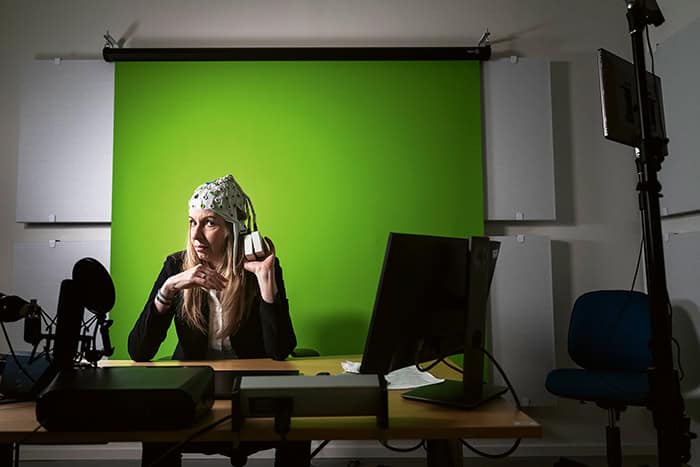
Foteini Simistira Liwicki describes herself as introverted and shy. Many of her conversations are with herself in her head. That’s what gave her the idea to research inner speech during her postdoc in Switzerland. But her shyness has given her an extra challenge when it comes to finding her rightful place as a woman in academic contexts.
She encountered this shyness – innate or a result of condescension and invisibility in a male-dominated domain? – in other female researchers at the conference.
“Even if you ask women to step forward, they don’t. We need to push them more. I got one woman to make herself available for the next conference by saying that I am also shy, but if we step up, more women will see us and be encouraged.”
On social media after the conference, a female doctoral candidate thanked her and two professors at Luleå University of Technology for their ”unwavering commitment” to increasing female representation in leadership roles.
Simistira Liwicki also needed encouragement to pursue a career in academia. She says that it was her former head of department at the university who helped her to put aside her shyness and apply for a job as associate senior lecturer.
“I am here thanks to him,” she says.
When he later walks by and she wants him to pose with her for a photo in Universitetsläraren, however, he protests. This is about her, not him, he says.
The qualification programme which Foteini Simistira Liwicki is part of includes a leadership programme. In gender equality literature, such initiatives are sometimes criticised for focusing on ”fixing women”, as if the inequality is about shortcomings in individual women rather a need to ”fix the system”, i.e. the structures that created the imbalances.
But perhaps the unequal structure – with its lack of representation, domination techniques etc. – has also created a need for compensatory leadership training among women in particular.
“The leadership programme, and talking to the other women on it, has helped me a lot when it comes to leading and being more visible and active,” she says.
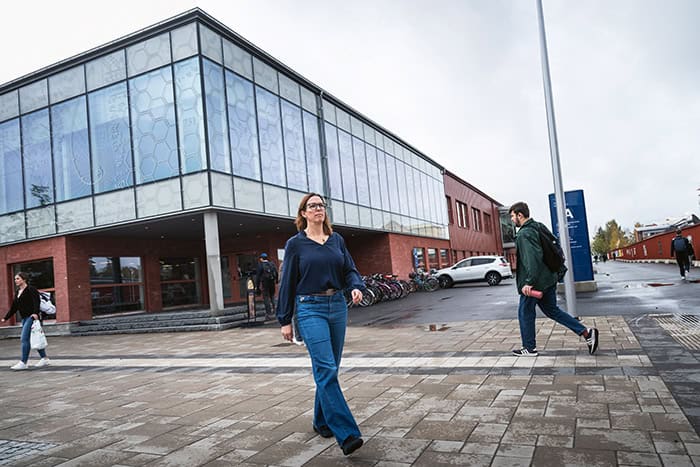
In another, more ordinary office on the campus, there are pictures of skydivers on the wall. One of them is Elisabeth Wetterlund. She has both a Swedish Championships gold medal and a European Championships bronze medal in parachuting. Two years ago, she became a professor of energy technology.
Her background and research, on the other hand, are more about energy systems – for example, the ongoing transition from fossil energy. In that field, the gender balance is better than in energy technology.
“But the higher you go in the academic hierarchy, the fewer women you find,” she says. “I notice that every time I put together an examining committee for a thesis defence, where there must be at least one person of the underrepresented gender.”
Since she became a docent, she has received more invitations to participate on various boards, committees and grant applications. These good intentions regarding representation can lead to women being overloaded with administrative tasks and having less time for the most meritorious part of academia: research.
The woman is sometimes also mostly a name on paper but is not part of the actual work, says Wetterlund.
“I have started to get better at saying no, even if that disappoints people. On the other hand, the invitations can provide opportunities that my male colleagues don’t always get, like being on an exciting panel or assessment team.”
Administrative and support tasks are sometimes called academic housework – things that need to be done and take time but are often invisible or of little merit when it comes to career progress. Sitting on an examining committee or a research council are among the more prestigious tasks in such work; everyday care and support are among the less meritorious.
“As a woman, I more often take or am expected to take responsibility so that things run nicely and smoothly,” says Wetterlund. “Like taking notes, suggesting that we buy buns for the meeting or that we go out for a bite to eat afterwards.”
Research from the USA in particular shows that women perform such service tasks in academia to a greater extent than men, at the expense of more meritorious work. Several universities, including Luleå University of Technology, are now looking at what the distribution of these tasks looks like locally.
Elisabeth Wetterlund has spoken at the leadership programme within the qualification initiative that Foteini Simistira Liwicki is participating in. Her message to the associate professors was to think strategically and focus on work that is valued in the academic system and that creates opportunities.
“Like building collaborative platforms that create opportunities to publish, supervise doctoral candidates and teach.”
She herself, on the other hand, describes her position as a professor as the result of a long series of lucky breaks. But that description was questioned by her manager earlier the same day.
“Men might think ‘I deserve this,’ while I think more ‘I was so damned lucky because I met Joakim at that conference and we had common interests and so one thing led to another and now I’m here’.”
Previously, Wetterlund also felt she was quite shy, but says that has ”passed”. Now she has a natural gravitas and laughs out loud. She believes that her success in a male-dominated field has been helped by her, mostly unconsciously, conforming to the norms there.
“I can go out into the sector and fit in. I can talk about hunting with my male colleagues, and then when we talk about research, they listen to me more because we have already bonded over something,” she says.
She wonders if the unconscious bias that can arise through identification has been a factor when she has recruited doctoral candidates – all women. But she and a colleague have also noted that the female applicants have often made more of an effort to show that they meet all the requirements set out in the advertisement.
Wetterlund sees that identification is important through the conversations that male colleagues’ female doctoral candidates choose to have with her.
“I can relate to their challenges and personality traits. Like ‘I was angry and wanted to scream, but I started to cry.’ I don’t know any men, but plenty of women, who describe their temperament in that way.”
She encourages her doctoral candidates to start a family during their doctoral studies, but she has no children herself and believes that this has made her career path smoother. A new study from the Center for Business and Policy Studies (SNS) confirms this. Among researchers who have become parents, the publication rate is 40 per cent lower for women than for men two years after the birth of their first child. After nine years, the women have fallen even further behind, with an 80 per cent lower publication rate. The gap does not seem to be affected by whether the mothers and fathers take a little or a lot of parental leave.
The situation at the time of the birth of the first child differs between the genders. Men already have a higher publication rate, and it is more than twice as common for men to have permanent employment as senior lecturers. The vast majority of women and men in the research profession, on the other hand, have their first child during the uncertain period at the beginning of their academic career.
“Publications beget publications, I believe. The first few years following a doctorate qualification are quite critical, and the men may also have made greater progress by the time they have children,” says Wetterlund.
The SNS report suggests support measures – such as more research time – for people returning from parental leave. Elisabeth Wetterlund has not thought along those lines, but Foteini Simistira Liwicki has. When her doctoral candidate returns from parental leave, she anticipates that she will need to instil him with more researcher self-confidence again and give him extra support to get back on track.
Simistira Liwicki and her husband, a professor at the same department, adopted two children themselves four years ago.
“But in our family, I have more of a father attitude and my husband has more of a maternal role, so I don’t think it has affected my publication rate,” she says.
Qualification initiatives such as the one for associate professors at Luleå University of Technology are a way of compensating for structural inequalities, which are shown in gaps between publication rates and a low percentage of women at professor level.
Tommy Viklund is the university’s HR director and tells us that a similar investment was made in 2015 and was successful.
“I would probably argue that it is one of the reasons why we are reaching our recruitment goals for professors. But the qualification process in academia takes time. The lessons from last time were that we need to invest in those who have already come a long way in order to get quick results, and to also have a leadership programme.”
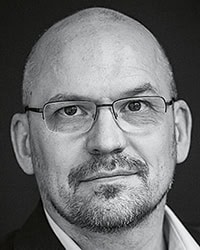
Tommy Viklund
HR director at Luleå University of Technology
On the walls of the room where we meet Viklund are large portraits of four of the university’s former vice-chancellors, two women and two men. Change efforts to achieve gender equality require robust support from management. Viklund says that they have had that for many years at the university, and do today with Birgitta Bergvall-Kåreborn as vice-chancellor.
“There is no fear of pushing the issues. There is certainly resistance, but there is in all matters, and I don’t think you should focus on that but on getting things done.”
Although he personally dislikes micromanagement, he thinks the assignment to achieve gender integration and recruitment goals for professors is positive. What he sees as the biggest threat to equality work is the danger that it will get lost among all other issues – so clear priorities and goals are needed.
Viklund highlights the university’s recruitment model as an important part of its integrated gender equality work. The university started using it in 2013 in order to have a common and gender-aware recruitment process.
“When we talk to the students, the most common question is why our focus is on gender equality. They want to talk about all forms of discrimination,” he says. “The other forms are more difficult to work with because we are not allowed to register ethnicity or sexual orientation. But tomorrow I’m going to a presentation on equality data. And if we make gender norms visible, we will hopefully make other norms visible as well.”

In the university library outside, groups of students are studying. There seems to be a fairly even mix of women and men, but not infrequently there are separate groups of men and of women.
At one of the windows sit four economics students – the university also has a large number of non-technological programmes. The students feel that the gender balance on their programme is fairly even, but that the jobs they are aiming for are male-dominated at the top.
Just a couple of weeks ago, they had a lecture on organisational culture, hierarchies, gender and minorities.
“It’s not just about learning about what it looks like, but about changing it, bringing it into the workplace and trying to break the glass ceiling and the sticky floor,” says James Aitomäki.
His course mate Emilia Keinström agrees.
“It’s good that we have this as part of our education – as long as you do something about it too and don’t just read about it.”
